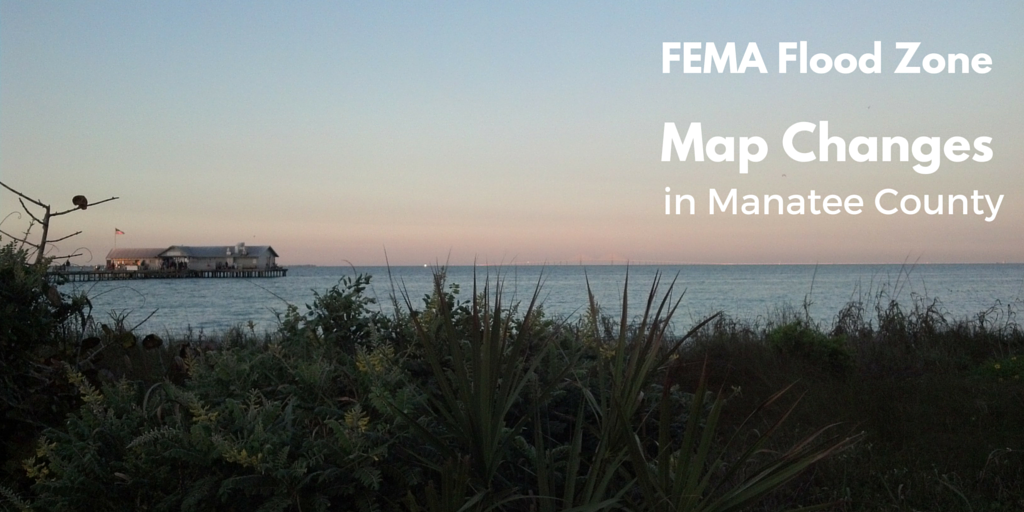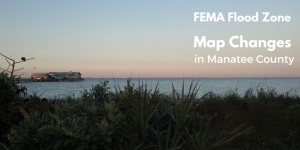
FEMA Flood Zone Maps in Manatee County
Learn about FEMA Flood Zone Maps in Manatee County as well as the proposed dates for changes in Sarasota County. This list includes Longboat Key, Anna Maria, Holmes Beach, Bradenton Beach, Bradenton & unincorporated Manatee County.
Longboat Key
Did you know that effective March 17, 2014 new FEMA Flood Zone Maps went into effect on Longboat Key, but only that portion in Manatee County? The new FEMA Flood Zone Maps for the Manatee County portion of Longboat Key modified the pre-existing required Base Flood Elevation, it is likely that residential structures existing prior to March 17, 2014 in those modified zones are now non-conforming and subject to FEMA’s 50% Rule.
Effective March 17, 2014, the Town of Longboat Key requires that new and existing residential structures in the FEMA A or AE Flood Zones must have their lowest (living) floor elevated to 1 foot above the currently required Base Flood Elevation? This means that on March 17, 2014 most existing residential structures in the FEMA A or AE Flood Zone are now non-conforming and subject to FEMA’s 50% Rule.
Did you also know that effective March 17, 2014, the Town of Longboat Key requires that new and existing residential structures in any Flood Zone seaward of the State of Florida Coastal Construction Control Line must have the bottom of the beam supporting 00483760-1 the lowest (living) floor elevated to at least 3 foot above the currently required Base Flood Elevation? This means that on March 17, 2014 many existing residential structures located seaward of the Coastal Construction Control Line are now non-conforming and subject to FEMA’s 50% Rule.
The FEMA Flood Zone Maps for the Manatee County portion of Longboat Key prior to March 17, 2014 expressed the required Base Flood Elevation in feet relative to “NGVD 1929” and as of March 17, 2014 in feet relative to “NAVD 1988″. To convert elevations in NGVD 1929 to NAVD 1988, you need to subtract 1 foot from the NGVD 1929 elevation. To convert elevations in NAVD 1988 to NGVD 1929 you need to add 1 foot to the NGVD 1988 elevation.
Elevations shown on Elevation Certificates prepared for properties in the Manatee County portion of Longboat Key before March 17, 2014 are expressed in relation to NGVD 1929. If you compare the pre-March 17, 2014 Elevation Certificates to the required Base Flood Elevation shown on the new FEMA Flood Zone Maps, you need to convert the old NGVD 1929 elevations to the new NAVD 1988 elevations shown on the new maps.
Unincorporated Manatee County
Did you know that the new FEMA Flood Zone Maps for the unincorporated areas of Manatee County that went into effect in 2014, may have modified the pre-existing required Base Flood Elevation? It is likely that residential structures existing prior to March 17, 2014 in those modified zones are now non-conforming and subject to FEMA’s 50% Rule?
Did you also know that the FEMA Flood Zone Maps for the unincorporated areas of Manatee County prior to March 17, 2014 expressed the required Base Flood Elevation in feet relative to “NGVD 1929” and as of March 17, 2014 in feet relative to “NAVD 1988”? To convert elevations in NGVD 1929 to NAVD 1988, you need to subtract 1 foot from the NGVD 1929 elevation. To convert elevations in NAVD 1988 to NGVD 1929 you need to add 1 foot to the NGVD 1988 elevation.
Elevations shown on Elevation Certificates prepared for properties in the unincorporated areas of Manatee County before March 17, 2014 are expressed in relation to NGVD 1929. If you compare the pre-March 17, 2014 Elevation Certificates to the required Base Flood Elevation shown on the new FEMA Flood Zone Maps, you need to convert the old NGVD 1929 elevations to the new NAVD 1988 elevations shown on the new maps.
The unincorporated area of Manatee County requires that new and existing residential structures in the FEMA A or AE Flood Zones must have their lowest (living) floor elevated to 1 foot above the currently required Base Flood Elevation? This means that on March 17, 2014 most existing residential structures in the FEMA A or AE Flood Zone are now non-conforming and subject to FEMA’s 50% Rule.
Did you also know that effective March 17, 2014, in the unincorporated areas, Manatee County requires that new and existing residential structures in the FEMA V or VE Flood Zone must have the bottom of the beam supporting the lowest (living) floor elevated to at least 2 feet above the currently required Base Flood Elevation if the beam is oriented perpendicular to the direction of wave approach? This means that starting on March 17, 2014 many existing residential structures located in the FEMA V or VE Flood Zone are now non-conforming and subject to FEMA’s 50% Rule.
Bradenton
Did you know that effective March 17, 2014 new FEMA Flood Zone Maps went into effect on Bradenton, but only that portion in Manatee County? The new FEMA Flood Zone Maps for the Manatee County portion of Bradenton modified the pre-existing required Base Flood Elevation, it is likely that residential structures existing prior to March 17, 2014 in those modified zones are now non-conforming and subject to FEMA’s 50% Rule.
Effective March 17, 2014, Bradenton requires that new and existing residential structures in the FEMA A or AE Flood Zones must have their lowest (living) floor elevated to 1 foot above the currently required Base Flood Elevation? This means that on March 17, 2014 most existing residential structures in the FEMA A or AE Flood Zone are now non-conforming and subject to FEMA’s 50% Rule.
Did you also know that effective March 17, 2014, Bradenton requires that new and existing residential structures in any Flood Zone seaward of the State of Florida Coastal Construction Control Line must have the bottom of the beam supporting 00483760-1 the lowest (living) floor elevated to at least 3 foot above the currently required Base Flood Elevation? This means that on March 17, 2014 many existing residential structures located seaward of the Coastal Construction Control Line are now non-conforming and subject to FEMA’s 50% Rule.
The FEMA Flood Zone Maps for the Manatee County portion of Bradenton prior to March 17, 2014 expressed the required Base Flood Elevation in feet relative to “NGVD 1929” and as of March 17, 2014 in feet relative to “NAVD 1988″. To convert elevations in NGVD 1929 to NAVD 1988, you need to subtract 1 foot from the NGVD 1929 elevation. To convert elevations in NAVD 1988 to NGVD 1929 you need to add 1 foot to the NGVD 1988 elevation.
Elevations shown on Elevation Certificates prepared for properties in the Manatee County portion of Bradenton before March 17, 2014 are expressed in relation to NGVD 1929. If you compare the pre-March 17, 2014 Elevation Certificates to the required Base Flood Elevation shown on the new FEMA Flood Zone Maps, you need to convert the old NGVD 1929 elevations to the new NAVD 1988 elevations shown on the new maps.
Anna Maria
Did you know that effective March 17, 2014 new FEMA Flood Zone Maps went into effect on Anna Maria, but only that portion in Manatee County? The new FEMA Flood Zone Maps for the Manatee County portion of Anna Maria modified the pre-existing required Base Flood Elevation, it is likely that residential structures existing prior to March 17, 2014 in those modified zones are now non-conforming and subject to FEMA’s 50% Rule.
Effective March 17, 2014, Anna Maria requires that new and existing residential structures in the FEMA A or AE Flood Zones must have their lowest (living) floor elevated to 1 foot above the currently required Base Flood Elevation? This means that on March 17, 2014 most existing residential structures in the FEMA A or AE Flood Zone are now non-conforming and subject to FEMA’s 50% Rule.
Did you also know that effective March 17, 2014, Anna Maria requires that new and existing residential structures in any Flood Zone seaward of the State of Florida Coastal Construction Control Line must have the bottom of the beam supporting 00483760-1 the lowest (living) floor elevated to at least 3 foot above the currently required Base Flood Elevation? This means that on March 17, 2014 many existing residential structures located seaward of the Coastal Construction Control Line are now non-conforming and subject to FEMA’s 50% Rule.
The FEMA Flood Zone Maps for the Manatee County portion of Anna Maria prior to March 17, 2014 expressed the required Base Flood Elevation in feet relative to “NGVD 1929” and as of March 17, 2014 in feet relative to “NAVD 1988″. To convert elevations in NGVD 1929 to NAVD 1988, you need to subtract 1 foot from the NGVD 1929 elevation. To convert elevations in NAVD 1988 to NGVD 1929 you need to add 1 foot to the NGVD 1988 elevation.
Elevations shown on Elevation Certificates prepared for properties in the Manatee County portion of Anna Maria before March 17, 2014 are expressed in relation to NGVD 1929. If you compare the pre-March 17, 2014 Elevation Certificates to the required Base Flood Elevation shown on the new FEMA Flood Zone Maps, you need to convert the old NGVD 1929 elevations to the new NAVD 1988 elevations shown on the new maps.
Bradenton Beach
Did you know that effective March 17, 2014 new FEMA Flood Zone Maps went into effect on Bradenton Beach, but only that portion in Manatee County? The new FEMA Flood Zone Maps for the Manatee County portion of Bradenton Beach modified the pre-existing required Base Flood Elevation, it is likely that residential structures existing prior to March 17, 2014 in those modified zones are now non-conforming and subject to FEMA’s 50% Rule.
Effective March 17, 2014, Bradenton Beach requires that new and existing residential structures in the FEMA A or AE Flood Zones must have their lowest (living) floor elevated to 1 foot above the currently required Base Flood Elevation? This means that on March 17, 2014 most existing residential structures in the FEMA A or AE Flood Zone are now non-conforming and subject to FEMA’s 50% Rule.
Did you also know that effective March 17, 2014, Bradenton Beach requires that new and existing residential structures in any Flood Zone seaward of the State of Florida Coastal Construction Control Line must have the bottom of the beam supporting 00483760-1 the lowest (living) floor elevated to at least 3 foot above the currently required Base Flood Elevation? This means that on March 17, 2014 many existing residential structures located seaward of the Coastal Construction Control Line are now non-conforming and subject to FEMA’s 50% Rule.
The FEMA Flood Zone Maps for the Manatee County portion of Bradenton Beach prior to March 17, 2014 expressed the required Base Flood Elevation in feet relative to “NGVD 1929” and as of March 17, 2014 in feet relative to “NAVD 1988″. To convert elevations in NGVD 1929 to NAVD 1988, you need to subtract 1 foot from the NGVD 1929 elevation. To convert elevations in NAVD 1988 to NGVD 1929 you need to add 1 foot to the NGVD 1988 elevation.
Elevations shown on Elevation Certificates prepared for properties in the Manatee County portion of Bradenton Beach before March 17, 2014 are expressed in relation to NGVD 1929. If you compare the pre-March 17, 2014 Elevation Certificates to the required Base Flood Elevation shown on the new FEMA Flood Zone Maps, you need to convert the old NGVD 1929 elevations to the new NAVD 1988 elevations shown on the new maps.
Holmes Beach
Did you know that effective March 17, 2014 new FEMA Flood Zone Maps went into effect on Holmes Beach, but only that portion in Manatee County? The new FEMA Flood Zone Maps for the Manatee County portion of Holmes Beach modified the pre-existing required Base Flood Elevation, it is likely that residential structures existing prior to March 17, 2014 in those modified zones are now non-conforming and subject to FEMA’s 50% Rule.
Effective March 17, 2014, Holmes Beach requires that new and existing residential structures in the FEMA A or AE Flood Zones must have their lowest (living) floor elevated to 1 foot above the currently required Base Flood Elevation? This means that on March 17, 2014 most existing residential structures in the FEMA A or AE Flood Zone are now non-conforming and subject to FEMA’s 50% Rule.
Did you also know that effective March 17, 2014, Holmes Beach requires that new and existing residential structures in any Flood Zone seaward of the State of Florida Coastal Construction Control Line must have the bottom of the beam supporting 00483760-1 the lowest (living) floor elevated to at least 3 foot above the currently required Base Flood Elevation? This means that on March 17, 2014 many existing residential structures located seaward of the Coastal Construction Control Line are now non-conforming and subject to FEMA’s 50% Rule.
The FEMA Flood Zone Maps for the Manatee County portion of Holmes Beach prior to March 17, 2014 expressed the required Base Flood Elevation in feet relative to “NGVD 1929” and as of March 17, 2014 in feet relative to “NAVD 1988″. To convert elevations in NGVD 1929 to NAVD 1988, you need to subtract 1 foot from the NGVD 1929 elevation. To convert elevations in NAVD 1988 to NGVD 1929 you need to add 1 foot to the NGVD 1988 elevation.
Elevations shown on Elevation Certificates prepared for properties in the Manatee County portion of Holmes Beach before March 17, 2014 are expressed in relation to NGVD 1929. If you compare the pre-March 17, 2014 Elevation Certificates to the required Base Flood Elevation shown on the new FEMA Flood Zone Maps, you need to convert the old NGVD 1929 elevations to the new NAVD 1988 elevations shown on the new maps.
Sarasota County
New FEMA Maps for Sarasota County are expected to go into effect in the Fall of this year.
Visit FLwaterfront.com for more information.

David M. Levin is a shareholder with the law firm of Icard, Merrill, Cullis, Timm, Furen & Ginsburg, P.A. of Sarasota, Lakewood Ranch and Punta Gorda, Florida. He limits his practice to environmental and waterfront property law, including waterfront property closings.
Mr. Levin has also been involved in environmental rule making and administrative rule challenges, and has represented both public and private clients in environmental litigation before federal, state, and administrative tribunals.
Mr. Levin has authored several published articles on environmental law topics and is a frequent lecturer on the subject.



